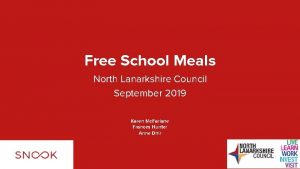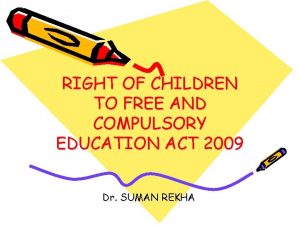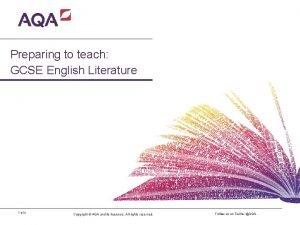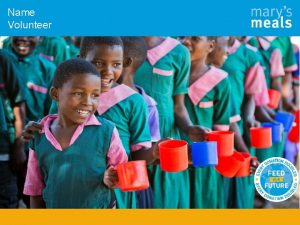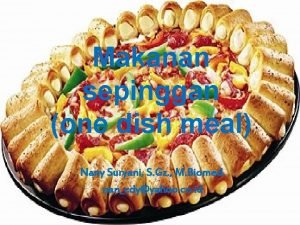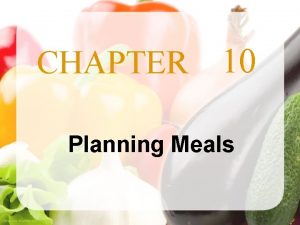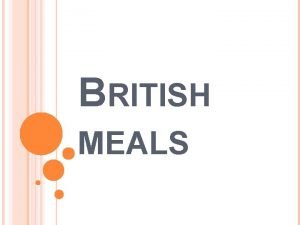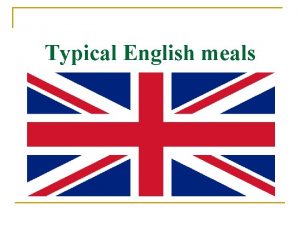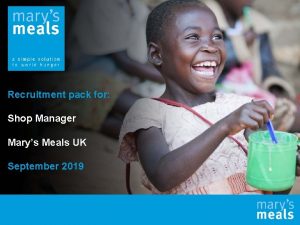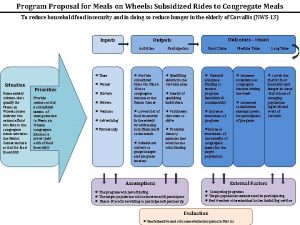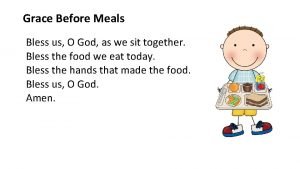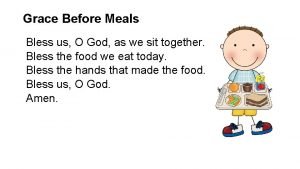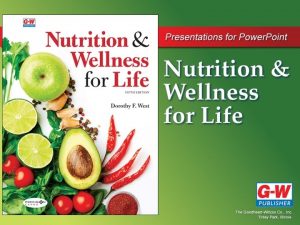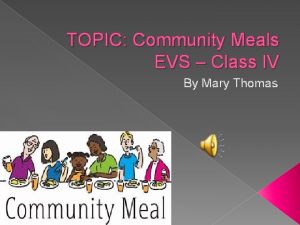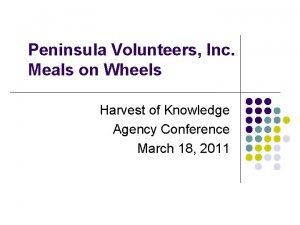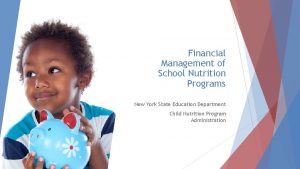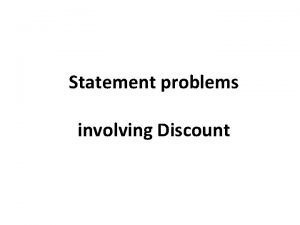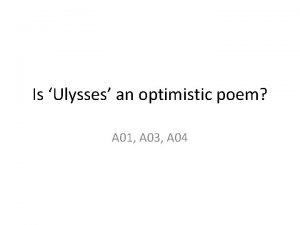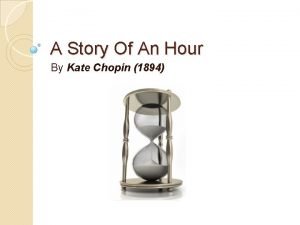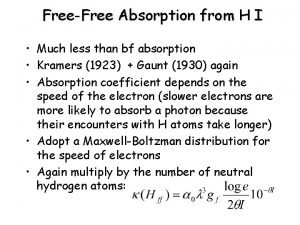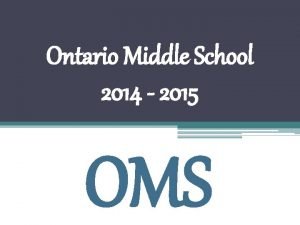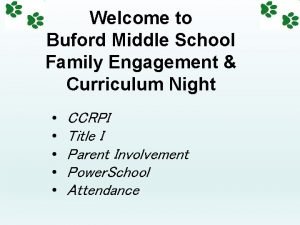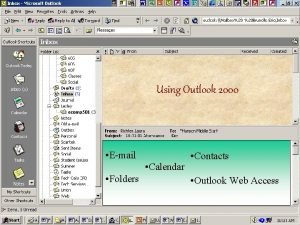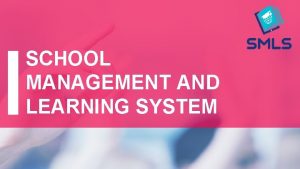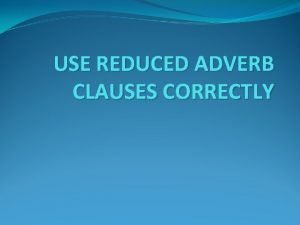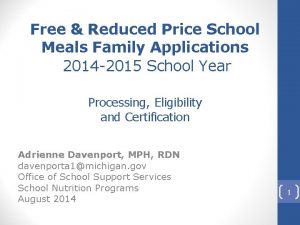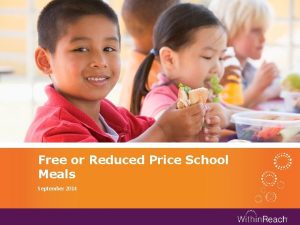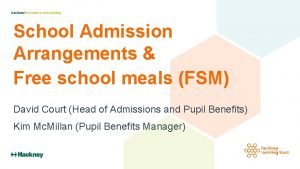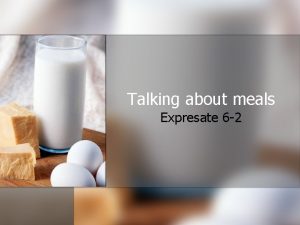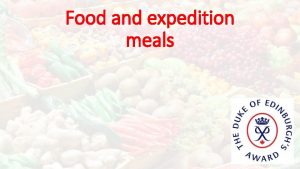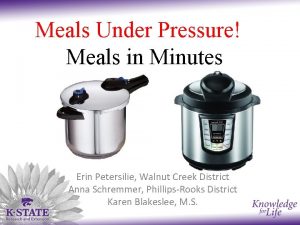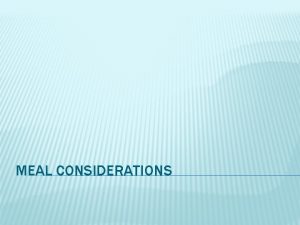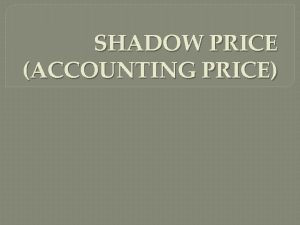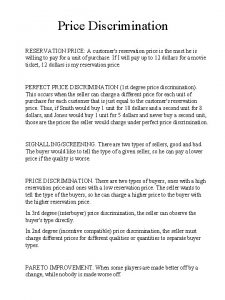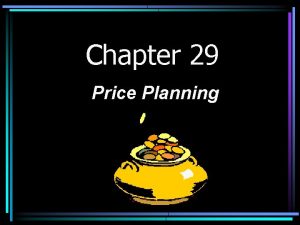Free Reduced Price School Meals Family Applications 2014










































- Slides: 42

Free & Reduced Price School Meals Family Applications 2014 -2015 School Year Processing, Eligibility and Certification Adrienne Davenport, MPH, RDN davenporta 1@michigan. gov Office of School Support Services School Nutrition Programs August 2014 1

Objectives Family Meals Apps: Processing, Eligibility and Certification Participants will understand: • Recent updates to application processing realm and how they apply to their own districts • How to process family meals applications and other documentation to determine eligibility status for School Nutrition Programs correctly • Where to find other support information 2

Free & Reduced Price School Meals Family Application www. michigan. gov/School. Nutrition 3

Recent Updates Application Double-Checks for Some • REQUIRED: Independent review of applications by a second reviewer before households are notified (doesn’t need to be district employee) (memo SP 44 -2014): • Required when: 1. 10% or more of certification/benefit issuance statuses in error – based on an Admin. Review (SFA 2 form); OR 2. State-determined criterion (TBD; USDA recommends 5 -10% error rate) • Second reviewer: Must conduct independent review of initial eligibility determinations for free and reduced apps 4

Recent Updates, cont’d Earlier Effective Dates • OPTIONAL: Districts may choose the date submitted instead of date approved as the “effective date” of free/reduced price determination (memo SP 11 -2014) • Need a way to document date submitted (e. g. , date stamp) • Applies to eligibility determinations via applications only • May be used when waiting for documentation of homeless, migrant or foster children based on an application • Must use the same date decision across all schools and programs 5

Recent Updates, cont’d Earlier Effective Dates • OPTIONAL: For children on the direct certification list, districts may choose the automated matching date or effective date of a letter of benefit, instead of the date the district processes the data match as the “effective date” (memo 51 -2014) • Must have been received in the current school year • Need a way to document date submitted (e. g. , date stamp) • If this is chosen, must be applied consistently • Memo attachment gives more scenarios and guidance 6

Recent Updates, cont’d Optional Drop of “Reduced” Charges • OPTIONAL: Districts allowed to partially say “Goodbye” to the “Reduced” category (memo 17 -2014) • Districts are allowed to offer meals at no cost or lower cost to students who qualify for reduced price meals • Applies to both breakfast (SBP) and lunch (NSLP) • Schools can exercise this option selectively • These students must still be claimed and reimbursed as reduced price students • Reduced charge can be covered by funds from the nonprofit school food service account or other sources • Universal Breakfast can use nonprofit food service account money to cover reduced kids, but not paid 7

Online and Scanned Applications • Free and reduced price family applications and supporting materials may be made available online. ü Electronic signatures permitted ü Paper applications may be scanned • USDA/FNS does not evaluate, approve or endorse any software for application processing. • The LEA must make sure requirements are met for certification and verification. 8

Free and Reduced Price School Meals Family Application 9

Part 1: Homeless, Migrant and Runaway Youth • Homeless, migrant, and runaway youth are categorically eligible (automatically qualify) for free meals. 10

Regular Year & Summer Migrant Program Directors Contact: Special Populations Unit, Office of Field Services P: 517 -373 -6066 11

Homeless Liaisons State of Michigan – Homeless Education Programs Contacts Pam Kies-Lowe Linda A. Forward P: 517 -373 -8691 P: 517 -373 -8480 E: kies-lowep@michigan. gov E: forwardl@michigan. gov 12

Part 2: Categorical Eligibility • Only one case number is required to make all students in the household categorically eligible (automatically free) for free meals. • Case numbers need to have nine digits and start with the number 1 (e. g. , #123456789) • List the name of the person receiving FAP or FIP benefits and the case number. • If a case number is provided, only students need to be listed in Part 3. 13

Part 2: Categorical Eligibility • Qualify as • Eligibility is extended to rest of household: categorically eligible Most cases on this slide (automatically free): Directly certified Foster children Homeless Migrant Head Start SNAP (formerly Food Stamps) • FDPIR • FAP • FIP (TANF) • • Exceptions: Families hosting foster and homeless children, Families with child in Head Start. These families must submit applications for other household members. 14

Direct Certification Students on the Direct Certification Report = Automatically eligible for free school meals, as are other members of their household. • Direct certification takes precedence over an application. • If a paper application is submitted for directly certified children, the LEA must disregard the paper application. • Access to the direct certification report is through the Michigan Student Data System (MSDS). • Must be checked 3 times during school year, though recommend checking monthly. 15

Categorical Eligibility for free meals is extended to all children in the household if any member of the household gets benefits from one of these assistance programs. Assistance Program Households – Entire Household is Free: • Food Assistance Program (SNAP) • Direct Certification • Application • Family Independence Program (TANF) • Direct Certification • Application • Food Dist. Program on Indian Reservations (FDPIR) • Application 16

Other Source Categorical Eligibility for free meals is NOT extended to all children in the household. Only the Child is Free: • Foster Children • Direct Certification • Application • Homeless, Runaway and Migrant • Signed list from coordinator/liaison • Application • Head Start/Even Start • Enrollment list from program coordinator 17

Foster Child Eligibility Foster children are automatically eligible for free meals and may be certified without an application. • A foster child in a household does not give eligibility for free meals to all children in the household. • Households with foster and non-foster children may choose to include the foster child as a household member, as well as any personal income earned by the foster child, on the same household application that includes their non-foster children. • This may help the other children in the household qualify for free/reduced price meals based on household size and income. 18

Foster Child Eligibility • Eligibility determination for the rest of the household is based on the household’s income (including personal income earned by the foster child) or other eligibility information reported on the application. • Foster payments received by the family from the placing agency are not considered income and do not need to be reported. • Legal guardianship is not an automatic qualifier for free meals. 19

Foster Child Eligibility For more information : • USDA policy memo SP 17 -2011, Child Nutrition Reauthorization 2010: Categorical Eligibility of Foster Children • • Electronic copy in jump drive Provides more detail on requirements 20

Part 3: Household Names • First and last names of all people living in the household must be included: ü Students ü Non-students ü Foster children related and unrelated ü Exchange students ü Grandparents ü Other relatives ü Friends ü The adult signing the application • All students must have the grade and name of the school/building they will be attending listed on the application. • An additional sheet may be attached if necessary. • All students should have the grade and name of the school/building they will be attending listed on the application. • An additional sheet may be attached if necessary. 21

Income Eligible Applications Income applications are required for students who are not: • Directly certified • Categorically eligible • Households must submit an application with current income information in order for benefits to be determined by household income. • Income is the gross income received by a household before deductions. • Every household member, listed in part 3, must indicate the source of the income, the amount of the income, even if it is zero and the frequency of the income. 22

Part 4: Total Household Gross Income Include the amount of money earned by all members of the household and circle how often it is received. • Must be gross income. • Other income includes, but is not limited to, social security, pensions, retirement, welfare, child support, alimony, adoption subsidy, worker’s compensation, unemployment, VA, and SSI. If a legitimate case number is listed in Part 2, skip to Part 5. 23

Income Frequency and Conversions • Income eligibility guidelines (IEGs) are the household size and income levels determined annually by USDA. • If there are multiple income sources with more than one frequency, the LEA must annualize income by multiplying: • Weekly income x 52 • Bi-weekly income (received every two weeks) x 26 • Semi-monthly income (received twice a month) x 24 • Monthly income x 12 • LEAs cannot use conversion factors such as 4. 33 to convert weekly income to monthly amounts. • If income frequency is the same, there is no need for annualizing. • Double check all software (SFA has liability). 24

Part 5: Adult Household Member Signature and Last 4 Digits of Social Security No. • An adult member of the household must sign and date the form, list the last four (4) digits of their Social Security Number, or check the box “I do not have a Social Security Number. ” 25

Part 6: Racial/Ethnic Data Collection • This section is optional. The data may be used for completing the post award civil rights data collection that is required annually. • Two categories, each is stand-alone (fill out both for every child): • Racial • Ethnic Fill out both for all 26

Part 6, cont’d • Make sure the privacy and non-discrimination statements are up to date. • Check www. michigan. gov/schoolnutrition for current version. • Verification of applications: • Must be completed by Nov. 15 th each year. • Note any reasons for change in eligibility based on verification results. 27

Part 6, cont’d: Updated Non-Discrimination Statement The U. S. Department of Agriculture prohibits discrimination against its customers, employees, and applicants for employment on the bases of race, color, national origin, age, disability, sex, gender identity, religion, reprisal, and where applicable, political beliefs, marital status, familial or parental status, sexual orientation, or all or part of an individual’s income is derived from any public assistance program, or protected genetic information in employment or in any program or activity conducted or funded by the Department. (Not all prohibited bases will apply to all programs and/or employment activities. ) If you wish to file a Civil Rights program complaint of discrimination, complete the USDA Program Discrimination Complaint Form, found online at http: //www. ascr. usda. gov/complaint_filing_cust. html, or at any USDA office, or call (866) 632 -9992 to request the form. You may also write a letter containing all of the information requested in the form. Send your completed complaint form or letter to us by mail at U. S. Department of Agriculture, Director, Office of Adjudication, 1400 Independence Avenue, S. W. , Washington, D. C. 20250 -9410, by fax (202) 690 -7442 or email at program. intake@usda. gov. Individuals who are deaf, hard of hearing or have speech disabilities may contact USDA through the Federal Relay Service at (800) 877 -8339; or (800) 845 -6136 (Spanish). USDA is an equal opportunity provider and employer. 28

Part 6, cont’d • The federally defined School Year is July 1 through June 30. • Applications cannot be accepted or processed prior to July 1. • All applications must be processed within 10 days of receipt (def’n up to SFA). • All households can reapply at any time during the school year if they believe their benefits may increase. • Households that have had their benefits terminated can reapply in the same school year but will need to submit proof of income or categorical eligibility. • Benefits should not be in effect if the application is not completed, dated, and signed by the determining official. 29

Benefits Prior to Processing Applications • 30 day grace period for benefits starting the first day of school and up to and including the 30 th day for: • Children in households with approved applications from the previous year. • Newly enrolled students with approved applications from the LEA from the previous year. • Previously approved children who transfer from one school to another under the jurisdiction of the same LEA. • Carryover of previous year’s eligibility also applies to: • Direct certification • Categorical eligibility • Head Start • The new eligibility determination supersedes the carryover eligibility. • Temporary approval is no longer in effect; eligibility status lasts whole year. 30

Administrative Approval • If a household fails to apply and the child is known to be eligible, local officials may complete an application on behalf of the child. The completed application should be: • Based on the best household size and income information available. • Limited use in individual situations and must not be used to make eligibility determinations for categories or groups of children. • Excluded from verification. • The household must be notified that the child has been certified to receive free or reduced price benefits. 31

Benefit Issuance List Every school district needs to compile a list with the names of students who are eligible for free and reduced price meals. This list should be: • Updated/revised monthly. • Used as documentation to support the monthly claim for reimbursement. • Available at the point of service for a back-up system in case of a power outage or technical difficulty. • Based on a system that hides free/reduced/paid status of students. 32

Sharing Information, Records and Documentation • Keep records for 3 years plus the current year. • Keep an “inactive” file for those students no longer attending school. • Eligibility information must never be shown in a way that students’ eligibility categories may be recognized by other students. • The numbers of eligible students, not names, can be shared with all programs (parental consent is needed for all other purposes). • For specific questions and answers regarding disclosure of eligibility, refer to section 7 of the Eligibility Manual. 33

Verification • What it is: A required yearly process of checking eligibility information for a sample of approved free and reduced price applications under the National School Lunch Program (NSLP) and School Breakfast Program (SBP). • To be covered in next section of training. 34

Language Assistance • Households with limited English proficiency (LEP) need to have access to information in other languages. • LEAs must make a reasonable effort to the maximum extent practicable. This includes: • Application materials • Communications with households concerning eligibility determinations • Volunteers may be used, but make sure they understand interpreter ethics – particularly confidentiality. • Children should not be used as interpreters. 35

Prototype Applications Available in 33 Languages http: //www. fns. usda. gov/cnd/frp. process. htm 36

Spanish Translation for School Meals Family Application www. michigan. gov/schoolnutrition • Scroll to “What’s New” • Click on School Year 2013 -2014 Free and Reduced Price Schools Meals Family Application Materials 37

Eligibility Manual For more information, please refer to the Eligibility Manual for School Meals Manual at: http: //www. fns. usda. gov/cnd/guid ance/default. htm The MDE website link: www. michigan. gov/School. Nutrition • Scroll to “Guidance” • Click on Eligibility Certification and Verification 38

Quiz: Sample Application #1 39

Quiz: Sample Application #2 40

Quiz: Sample Application #3 41

Questions? • School Nutrition Programs • 517 -373 -3347 • MDE-schoolnutrition@michigan. gov • Website: www. Michigan. gov/School. Nutrition 42
 School meals north lanarkshire
School meals north lanarkshire Kahulugan ng price freeze
Kahulugan ng price freeze Salient features of rte 2009
Salient features of rte 2009 How to leave the world that worships should
How to leave the world that worships should Mary's meals malawi
Mary's meals malawi Macam macam makanan sepinggan
Macam macam makanan sepinggan Ameriqual apack
Ameriqual apack Balanced diet for breakfast lunch and dinner
Balanced diet for breakfast lunch and dinner Chapter 10 planning meals
Chapter 10 planning meals Meal times in english
Meal times in english Typical english cuisine
Typical english cuisine Paleo zone diet
Paleo zone diet Mary's meals northern ireland
Mary's meals northern ireland Subsidized meals
Subsidized meals Eat meals that are nutritious agree or disagree
Eat meals that are nutritious agree or disagree Our father prayer
Our father prayer Bless us oh god as we sit together
Bless us oh god as we sit together Planning meals chapter 10 study sheet
Planning meals chapter 10 study sheet Eating together class 4 evs worksheets
Eating together class 4 evs worksheets Three main meals
Three main meals Meals on wheels san mateo
Meals on wheels san mateo In your notebook write the names of meals
In your notebook write the names of meals Meals on wheels st mary's county md
Meals on wheels st mary's county md Meals per labor hour formula
Meals per labor hour formula Answer the question write your answer on your notebook
Answer the question write your answer on your notebook Marked price-selling price=
Marked price-selling price= Instalment payment system
Instalment payment system Reactive sourcing
Reactive sourcing Price discovery and price determination
Price discovery and price determination Gibbs free energy spontaneous
Gibbs free energy spontaneous How to find free energy
How to find free energy Is delta g free energy
Is delta g free energy A free map determines which blocks are free, allocated.
A free map determines which blocks are free, allocated. Helmholtz free energy and gibbs free energy
Helmholtz free energy and gibbs free energy Free hearts free foreheads you and i are
Free hearts free foreheads you and i are Summary of story of an hour
Summary of story of an hour Free free absorption
Free free absorption Oms ontario
Oms ontario Technology applications middle school lessons
Technology applications middle school lessons Technology applications middle school
Technology applications middle school Technology applications middle school
Technology applications middle school Technology applications middle school
Technology applications middle school Kokanee salmon begin to deteriorate and die soon
Kokanee salmon begin to deteriorate and die soon
